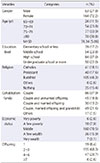Abstract
Purpose
This study was conducted to construct and test a structural model on family life satisfaction of aged individuals living at home. The conceptual model was based on Bandura's self-efficacy and social cognitive theories (1977; 1986) and Bowen's (1976) family systems theory.
Methods
From January 25 to March 5, 2016, 227 older adults living at home completed a structured questionnaire. Data were analyzed to calculate the direct and indirect effects of factors affecting family life satisfaction. SPSS WIN 20.0 and AMOS 20.0 were used.
Results
The hypothetical model was a good fit for the data. The model fit indices were χ2=78.05, χ2/df=1.35, RMSR=.02, GFI=.98, AGFI=.96, NFI=.94, CFI=.98, and RMSEA=. 05. Family life satisfaction was positively affected by perceived collective family efficacy, status of physical health, family communication, and family support. Depression resulted in a significant negative effect. Family differentiation had a significant indirect effect on family life satisfaction. The model explained 76% of variance in family life satisfaction.
Conclusion
Perceived collective family efficacy, status of physical health, depression, family differentiation, family communication, and family support were significant factors explaining family life satisfaction among older adults staying at home. Further research should be conducted to seek intervention strategies to improve family life satisfaction among older adults living at home by focusing on the respective contributing factors.
Figures and Tables
Notes
References
1. Statistics Korea. Population projections for Korea (2000–2050) [Internet]. Daejeon: Statistics Korea;c2001. cited 2016 Jan 18. Available from: http://lib1.kostat.go.kr/search/detail/CATTOT000000027973.
2. Eliopoulos C.
YH Park
SJ Kim
YJ Kim
JS Park
SH Seok
DS Shin
. Gerontological nursing. 1st Korean. Ed. Paju: Soomoonsa;c2015. p. 556.
3. Bandura A, Caprara GV, Barbaranelli C, Regalia C, Scabini E. Impact of family efficacy beliefs on quality of family functioning and satisfaction with family life. Appl Psychol. 2011; 60(3):421–448. DOI: 10.1111/j.1464-0597.2010.00442.x.

4. Bandura A. Self-efficacy: The exercise of control. . New York: Freeman;1997. p. 1–604.
5. Woźniak B. Religiousness, well-being and ageing-selected explanations of positive relationships. Anthropol Rev. 2015; 78(3):259–268. DOI: 10.1515/anre-2015-0021.
6. Kee BS. A preliminary study for the standardization of geriatric depression scale short form-Korea version. J Korean Neuropsychiatr Assoc. 1996; 35(2):298–307.
7. Ro KY. Korean's sucide rate 1st dishonor. Kyonggi Newspaper [Internet]. Blog of kyroh21;2016. 01. 18. cited 2016 Jan 18. Available from: http://blog.daum.net/kyroh21/15862043.
8. Bowen M. Theory in the practice of psychotherapy. In : Guerin PJ, editor. Family Therapy. New York: Gardner Press;1976. p. 1–553.
9. Lee JY, Chung HJ. Psychological adjustment of elderly couples: Based on Bowen's family systems theory. J Fam Relat. 2008; 13(1):1–27.
10. Lee JM. The effects of family differentiation from the family of origin, marital communication, and marital intimacy on the family strengths of married women in their twenties and thirties. J Korean Home Manage Assoc. 2013; 31(6):23–38. DOI: 10.7466/JKHMA.2013.31.6.23.

11. An YH. Family nursing. 2nd ed. Seoul: Hyunmoonsa;2013. p. 1–263.
12. Jung SS, Ha KS. Study of the influence of the depressive mood of the elderly: Focused on the mediating effect of communication between families and self-esteem. J Korea Acad Ind Coop Soc. 2014; 15(9):5525–5533. DOI: 10.5762/KAIS.2014.15.9.5525.
13. Poulin J, Deng R, Ingersoll TS, Witt H, Swain M. Perceived family and friend support and the psychological well-being of American and Chinese elderly persons. J Cross Cult Gerontol. 2012; 27(4):305–317. DOI: 10.1007/s10823-012-9177-y.

14. Olson DH, Russel CS, Sprenkle DH. Circumplex model of Marital and Family Systems: VI. Theoretical update. Fam Process. 1983; 22(1):69–83. DOI: 10.1111/j.1545-5300.1983.00069.x.
15. Caprara GV, Pastorelli C, Regalia C, Scabini E, Bandura A. Impact of adolescents' filial self-efficacy on quality of family functioning and satisfaction. J Res Adolesc. 2005; 15(1):71–97. DOI: 10.1111/j.1532-7795.2005.00087.x.

16. McEwen M. Philosophy, science, and nursing. In : McEwen M, Wills EW, editors. Theoretical Basis for Nursing. 2nd ed. Philadelphia (PA): Lippincott Williams and Wilkins;2007. p. 3–22.
17. Bandura A. Social foundations of thought and action: A social cognitive theory. Englewood Cliffs (NJ): Prentice-Hall;1986. p. 24.
18. Bandura A. Self-efficacy: Toward a unifying theory of behavioral change. Psychol Rev. 1977; 84(2):191–215.

19. Anderson SA, Sabatelli RM. The differentiation in the family system scale (DIFS). Am J Fam Ther. 1992; 20(1):77–89. DOI: 10.1080/01926189208250878.

20. Yu JP. The concept and understanding of structural equation modeling: Amos 4.0~20.0. Seoul: Hannarae Publishing Co;2012. p. 1–567.
21. Olson DH, Stewart K. Health and stress profile. Minneapolis (MN): Life Innovations;1989. p. 1–46.
22. Caprara GV, Regalia C, Scabini E, Barbaranelli C, Bandura A. Assessment of filial, parental, marital, and collective family efficacy beliefs. Eur J Psychol Assess. 2004; 20(4):247–261. DOI: 10.1027/1015-5759.20.4.247.

23. Ko KD. A study on rural aged people's health conditions and their service needs [master's thesis]. Wonju: Sangji University;2010. 1–63.
24. Sixbey MT. Development of the family resilience assessment scale to identify family resilience constructs [dissertation]. Gainesville (FL): University of Florida;2005. 1–171.
25. Cobb S. Social support as moderator of life stress. Psychom Med. 1976; 38(5):300–314.
26. Kang HS. An experimental study of the effects of reinforcement education for rehabilitation on hemiplegia patients' selfcare activities [dissertation]. Seoul: Yonsei University;1984. 1–125.
27. Bandura A. Social cognitive theory of mass communication. Media Psychol. 2001; 3(3):265–299. DOI: 10.1207/S1532785XMEP0303_03.

28. Sok SR. A Comparative study on physical health status, family support, and life satisfaction between the aged living alone and living with family. J Korean Acad Community Health Nurs. 2008; 19(4):564–574.
29. Yoo HN, Han HY, Oh HM, Park MJ. The effects of family communication and family cohesion on elderly women's depression and quality of life. J Korean Data Anal Soc. 2015; 17(1):469–483.
30. Choi YH, Shin KR, Kim OS, Ko SH, Kong US, Kim KH, et al. Elderly and health. 5th ed. Seoul: Hyunmoonsa;2014. p. 1–482.




 PDF
PDF ePub
ePub Citation
Citation Print
Print








 XML Download
XML Download